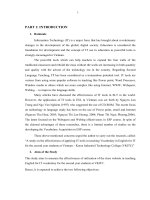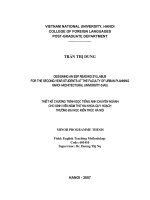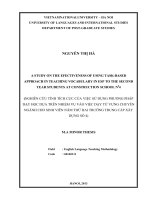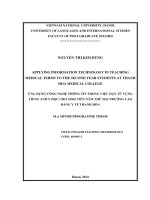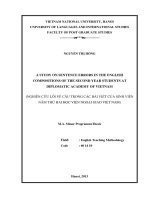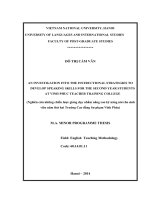Difficulties encountered in the toeic listening test by the second year students at university of economics and business administration thai nguyen university
Bạn đang xem bản rút gọn của tài liệu. Xem và tải ngay bản đầy đủ của tài liệu tại đây (1.59 MB, 65 trang )
VIETNAM NATIONAL UNIVERSITY, HANOI
UNIVERSITY OF LANGUAGES AND INTERNATIONAL STUDIES
FACULTY OF POST-GRADUATE STUDIES
*****************
DƯƠNG THANH HẢO
DIFFICULTIES ENCOUNTERED IN THE TOEIC LISTENING TEST
BY THE SECOND-YEAR STUDENTS AT UNIVERSITY OF
ECONOMICS AND BUSINESS ADMINISTRATION THAI NGUYEN UNIVERSITY
NHỮNG KHÓ KHĂN KHI LÀM BÀI THI NGHE TOEIC
CỦA SINH VIÊN NĂM THỨ 2 TRƯỜNG ĐẠI HỌC KINH TẾ VÀ
QUẢN TRỊ KINH DOANH THÁI NGUYÊN
M.A. MINOR PROGRAMME THESIS
Field : English Teaching Methodology
Code : 60140111
Hanoi – 2016
VIETNAM NATIONAL UNIVERSITY, HANOI
UNIVERSITY OF LANGUAGES AND INTERNATIONAL STUDIES
FACULTY OF POST-GRADUATE STUDIES
*****************
DƯƠNG THANH HẢO
DIFFICULTIES ENCOUNTERED IN THE TOEIC LISTENING TEST
BY THE SECOND-YEAR STUDENTS AT UNIVERSITY OF
ECONOMICS AND BUSINESS ADMINISTRATION THAI NGUYEN UNIVERSITY
NHỮNG KHÓ KHĂN KHI LÀM BÀI THI NGHE TOEIC
CỦA SINH VIÊN NĂM THỨ 2 TRƯỜNG ĐẠI HỌC KINH TẾ VÀ
QUẢN TRỊ KINH DOANH THÁI NGUYÊN
M.A. MINOR PROGRAMME THESIS
Field
: English Teaching Methodology
Code
: 60140111
Supervisor : Assoc.Prof. Dr. Lâm Quang Đông
Hanoi – 2016
DECLARATION
I declare that this minor thesis entitled “Difficulties encountered in the TOEIC listening
test by the second-year students at University of Economics and Business
Administration, Thai Nguyen University” submitted in partial fulfillment of the
requirements for the Degree of Master of Arts is the results of my own work and that is
thesis does not contain material which has been accepted for the award of any degree or
diploma in any university, nor does it contain material previously published or written by
any other person, except where due reference is made in the text of the thesis.
Hanoi, 2016
Duong Thanh Hao
i
ACKNOWLEDGEMENTS
In the process of doing my research paper, I have received a lot of help and
encouragement from teachers and colleagues.
First and foremost, I would like to express my sincere thanks to my supervisor
Assoc.Prof. Dr. Lâm Quang Đông who has generously given me invaluable
assistance and guidance. Without his help, this paper would not have been
successfully completed.
Secondly, my graduation subject now is completed successfully thanks to all
teachers‟ support at University of Economics and Business Administration, Thai
Nguyen University (TUEBA) who did their best to help me gather data from
students‟ questionnaires.
Besides, my sincere thanks are also extended to all the students who helped me
fulfill the survey questions and interviews. Finally, I am grateful to my family
and friends who have given me much encouragement throughout.
ii
ABSTRACT
The study investigates difficulties in TOEIC listening comprehension
encountered by a group of sophomore students of TUEBA. 50 sophomores at
TUEBA were selected for the study.
The data were gathered by means of students‟ listening test papers,
questionnaires and semi-structured interviews. The results of the study showed
that general linguistic ability, background knowledge and facilities were the
major TOEIC listening comprehension difficulties encountered by second-year
students at TUEBA. While doing the TOEIC test, the study‟s participants
normally applied such strategies as guessing or predicting, identifying types of
question in part 2, and listening for gist and details. On that basis, suggestions
and recommendations were provided so as to deal with the problems.
This work hopes to be useful for those who are interested in this subject and to
pave the way for future studies in this field.
iii
TABLE OF CONTENTS
DECLARATION ................................................................................................... I
ACKNOWLEDGEMENTS .................................................................................. II
ABSTRACT ......................................................................................................... III
TABLE OF CONTENTS .....................................................................................IV
LIST OF ABBREVIATIONS ............................................................................ VII
PART A: INTRODUCTION............................................................................... 1
1. RATIONALE OF THE STUDY ................................................................................. 1
2. OBJECTIVES OF THE STUDY ................................................................................ 1
3. SIGNIFICANCE OF THE STUDY ............................................................................. 2
4. SCOPE OF THE STUDY.......................................................................................... 2
5. METHODS OF THE STUDY .................................................................................... 2
6. ORGANIZATION OF THE THESIS........................................................................... 2
PART B: DEVELOPMENT ............................................................................... 4
CHAPTER 1- LITERATURE REVIEW ........................................................... 4
1.1. THEORETICAL BACKGROUND TO LISTENING COMPREHENSION ...................... 4
1.1.1. Listening strategies ...................................................................................... 4
1.1.2. Processes of listening comprehension ......................................................... 6
1.1.3. Potential problems in listening comprehension ........................................... 7
1.2. TOEIC TEST ..................................................................................................... 7
1.2.1. Overview of the TOEIC test. ........................................................................ 7
1.2.2. TOEIC listening ........................................................................................... 9
1.2.3. TOEIC listening strategies ......................................................................... 13
1.3. RELATED STUDIES OF LISTENING COMPREHENSION AND TOEIC LISTENING14
CHAPTER 2: METHODOLOGY.................................................................... 16
2.1 SELECTION OF PARTICIPANTS ......................................................................... 16
2.2 RESEARCH INSTRUMENTS ............................................................................... 16
2.2.1 Students’ listening test papers..................................................................... 16
2.2.2 Questionnaires ............................................................................................ 17
2.2.3 Semi-structured interviews. ......................................................................... 18
iv
2.3. DATA COLLECTION PROCEDURES .................................................................. 18
2.4. DATA ANALYSIS PROCEDURE ........................................................................ 19
CHAPTER 3: FINDINGS AND DISCUSSION .............................................. 21
3.1 WHAT DIFFICULTIES DO THE SECOND-YEAR STUDENTS AT TUEBA FACE IN
THE TOEIC LISTENING TEST?............................................................................... 21
3.1.1 Students’ opinions of TOEIC listening test ................................................. 21
3.1.2 Students’ opinions of TOEIC listening difficulties related to background
knowledge and linguistic ability........................................................................... 22
3.1.3 Students’ opinions of listening difficulties related to listener or nonlinguistic factors ................................................................................................... 25
3.1.4 Types of difficulties of each part in TOEIC listening test through analyzing
TOEIC listening test papers ................................................................................. 27
3.2 WHAT CAUSES SUCH DIFFICULTIES? .............................................................. 31
3.3 WHAT STRATEGIES DO THESE STUDENTS OFTEN APPLY WHEN TAKING TOEIC
LISTENING TEST? .................................................................................................. 34
3.5 SUMMARY ....................................................................................................... 36
PART C: CONCLUSION ................................................................................. 37
1. SUMMARY OF THE STUDY ................................................................................. 37
2. PEDAGOGICAL RECOMMENDATIONS TO IMPROVE STUDENTS‟ TOEIC
LISTENING RESULTS .............................................................................................. 38
2.1 To the students................................................................................................ 38
2.2 To the teachers ............................................................................................... 38
3. LIMITATIONS OF THE STUDY ............................................................................. 39
4. SUGGESTIONS FOR FURTHER STUDIES .............................................................. 39
REFERENCES ................................................................................................... 41
APPENDIX 1 ........................................................................................................ I
APPENDIX 2: INTERVIEWS ......................................................................... IX
v
LIST OF CHARTS AND TABLES
Chart 1: students‟ opinions about the difficult level of toeic listening test ......... 21
Chart 2: students‟ opinions of the most difficult part of toeic listening test. ...... 22
Chart 3: students‟ opinions of toeic listening difficulties related to background
knowledge. ........................................................................................................... 23
Chart 4: types of difficulties in toeic listening test and their percentage ............. 28
Chart 5: tueba second-year students‟ suggestions for handling such difficulties
.............................................................. ERROR! BOOKMARK NOT DEFINED.
Table 1: students‟ opinions of toeic listening difficulties related to linguistic
ability .................................................................................................................... 24
Table 2: students‟ opinions of listening difficulties related to listener (nonlinguistic factors) .................................................................................................. 26
Table 3: causes of toeic listening difficulties ....................................................... 31
Table 4: strategies applied by students when taking toeic listening test ............. 34
vi
LIST OF ABBREVIATIONS
TUEBA:
University of Economics and Business Administration,
Thai Nguyen University
TOEIC:
Test of English for International Communication
ETS:
Educational Testing Service
ESL
English as a Second Language
L2 learners: Second Language learners
vii
PART A: INTRODUCTION
1. Rationale of the study
As an international language, English obviously plays a crucial role in the age of
global economic integration. The scores of worldwide standardized English tests
such as the Test of English for International Communication (TOEIC), the Test
of English as a Foreign Language (TOEFL) and the International English
Language Testing System (IELTS) are widely used as recognized evidence of
one‟s English proficiency, especially the TOEIC test. Most companies require
TOEIC certificates as one of their employees‟ qualifications.
Many colleges and universities like TUEBA have used the TOEIC test to
classify students‟ English proficiency, place them into the right classes and use
their test‟s results at the end of each course to calculate credits. Moreover, the
minimum TOEIC score of 450 is a compelling requisite for students to meet the
requirement of graduation. Among all the skills tested, listening is always the
hardest to second, or foreign, language learners, and my students at TUEBA are
no exception.
Being an English teacher at TUEBA, through my teaching experience, I notice
that comparing to other skills, students find listening most difficult and stressful
and their TOEIC listening scores tend to be lower than those of other skills.
For all of the above mentioned reasons, I would like to carry out a small study
entitled “Difficulties encountered in the TOEIC listening test by the second-year
students at university of Economics and Business Administration, Thai Nguyen
University “in order to help solve out the problems.
2. Objectives of the study
The purpose of the study is to investigate the TOEIC listening comprehension
difficulties encountered by the second-year students at University of Economics
and Business Administration, Thai Nguyen University, identify the factors that
lead to such difficulties and suggest solutions to help students overcome these
1
problems. To that end, the study seeks answers to the following research
questions:
1. What difficulties do the second-year students at TUEBA face in the TOEIC
listening test?
2. What causes such difficulties?
3. What strategies do these students often apply when taking TOEIC listening test?
3. Significance of the study
This study explores the real difficulties encountered by sophomores as well as
their strategies to improve their scores in TOEIC listening test. Also, the study
hopes to offer some help to TUEBA teachers in their choice of appropriate
techniques to teach TOEIC listening effectively.
4. Scope of the study
The study focuses mainly on the analysis of the data collected from the students‟
TOEIC listening test papers and the survey questionnaire distributed to TOEIC
students at the University of Economics and Business Administration- Thai
Nguyen University.
5. Methods of the study
Both quantitative and qualitative approaches were employed but the major method
used is the quantitative method. The analysis of students‟ TOEIC listening test papers
was done to identify the current situation as well as difficult aspects of the TOEIC
listening test. Then, additional data were also collected through survey questionnaires,
informal interviews and discussions with TOEIC learners at TUEBA.
6. Organization of the thesis
This thesis consists of three parts:
Part A: Introduction. This part supplies an overview of the study with specific
reference to the rationale, the aims, the methodology and the structure of the thesis.
Part B: Development. In this part, four chapters are presented.
Chapter 1 – Literature Review establishes the theoretical background of the
2
research. It is concerned with the issues relevant to the topic of the research, i.e.
listening comprehension and an overview of TOEIC listening comprehension tests.
Chapter 2 – Methodology presents the background information of the
participants in the study, the instrument used to collect the data, and the
procedure of data collection.
Chapter 3 – Findings and Discussion provides the data analysis in detail and a
thorough discussion of the findings of the study. Explanations and interpretations
of the findings are also presented in this chapter.
Part C: Conclusion. In this part, the limitations and some recommendations for
further research are provided.
The Appendices lie on the last part of the study, following the References.
3
PART B: DEVELOPMENT
CHAPTER 1- LITERATURE REVIEW
1.1. Theoretical background to listening comprehension
1.1.1. Listening strategies
1.1.1.1. Definition of listening comprehension strategy
Listening strategies are techniques or activities that contribute directly to the
comprehension and recall of listening input (Rubin, 1981).
Listening strategies can be classified on the basis of how the listener processes the
input.
For learners, one of the methods learners can become actively involved in
controlling their own learning is by using strategies. Vandergrift (1999) showed
“Strategy development is important for listening training because strategies are
conscious means by which learners can guide and evaluate their own
comprehension and responses.” In O'Malley, Chamot, Stewner-Manzanares,
Kupper, and Russo‟s (1985) study, high school ESL students were randomly
assigned to receive learning strategy training on vocabulary, listening, and
speaking tasks and the result indicated strategy training can be effective for
integrative language tasks. Nakata (1999) studied the influence of listening
strategy training on Japanese EFL learners‟ listening competence, and it
showed that the effect of listening strategy training was more discernible on
perception than on comprehension.
Among all the strategies for listening, O‟Malley and Chamot (1990) claimed
three main types of strategies: metacognitive, cognitive and social strategies. The
metacognitive strategy was a kind of self-regulated learning. It included the
attempt to plan, check, monitor, select, revise, and evaluate, etc. For example, for
metacognitive planning strategies, learners would clarify the objectives of an
anticipated listening task, and attend to specific aspects of language input or
situational details that assisted in understanding the task (Vandergrift, 1999).
4
The cognitive strategies are related to comprehending and storing input in
working memory or long-term memory for later retrieval. They are investigated
from the aspects of bottom-up strategies, top-down strategies. For bottom-up
processing, it refers to using the incoming input as the basis for understanding
the message. Comprehension begins with the received data that are analyzed as
successive levels of organization-sounds, words, as a process of decoding. For
bottom-up strategies, Henner-Stanchina (1987) engaged in a similar study and
pointed out that effective listeners were good at using their previous knowledge
and experience to raise hypotheses about a text, integrating new information into
their ongoing interpretations, making influences to bridge gaps, assessing their
interpretations, and modifying their hypotheses, if necessary. On the other hand,
top-down processing goes from meaning to language (Richards, 2008). Learners
can try to predict what will be uttered by the signal. However, Chiu (2006)
claimed that listening comprehension was neither only top-down nor bottom-up
processing. Simultaneously, Lu (2008) summed up that the scholars believed the
listeners not only utilized bottom-up but also top-down processing models. In
sum, Thompson & Rubin (1996) indicated the effects of metacognitive and
cognitive strategy instruction on the listening comprehension performance of
American university students learning Russian. They found that the subjects who
received strategy instruction in listening to video-recorded texts improved
significantly over those who had received no instruction.
For social/ affective strategies, Vandergrift (2003) defined the strategies as the
techniques listeners used to collaborate with others, to verify understanding or to
lower anxiety. Habte-Gabr (2006) stated that socio-affective strategies were
those which were non-academic in nature and involve stimulating learning
through establishing a level of empathy between the instructor and student. They
included considering factors such as emotions and attitudes (Oxford, 1990). It
was essential for listeners to know how to reduce the anxiety, feel confident in
5
doing listening tasks, and promote personal motivation in improving listening
competence (Vandergrift, 1997). According to O‟Malley &Chamot (2001),
among the four strategies of management strategies, social strategies, cognitive
strategies, affective strategies in listening comprehension, both social and
affective strategies influenced the learning situation immediately.
1.1.1.2. Classification of listening strategies
As stated by Hedge, 2000; listening strategies include top-down and bottom-up
strategies. First, top-down strategies are listener based, which means that the
listener uses background knowledge of the topic, the context, the type of text,
and the language with a set of expectations to make sense of what is hear and
anticipate what will come next. Top-down strategies consist of listening for the
main idea, predicting, drawing inferences, summarizing.
Second, bottom-up strategies are text-based– that is, the listener relies on his/her
knowledge of the language in the message, for example, the combination of sounds,
words, and grammar to construct meaning. Bottom-up strategies include listening
for specific details, recognizing cognates, recognizing word-order patterns.
1.1.2. Processes of listening comprehension
As reported by Rost (2002), the processes of listening comprehension have often
been viewed in a two-level view: bottom-up and top-down processing. In
bottom-up processing, listeners first pay attention to individual phonological
units, then decode a large unit of input in hierarchical order, from vocabulary to
structures, for the meaning of the discourse. In top-down processing, listeners
draw upon the background information, contextual information and expectation
for comprehension. Listening comprehension is considered as an interactive
process of bottom-up processing and top-down processing by using linguistic
and real world information (Rost, 1994, p. 32; Nunan, 1999, p.221)
6
1.1.3. Potential problems in listening comprehension
Underwood (1989) suggests seven potential problems that could hinder listening
comprehension.
First, “many language learners believe that the greatest difficulty with listening
comprehension, as opposed to remind comprehension, is that listener cannot
control how quickly a speaker speaks” (Underwood, 1989, p.16).
Second, it is not always possible for learners to have words repeated. It is “hard
for the teacher to judge whether or not the students have understood any
particular section of what they have heard” (Underwood, 1989, p.17).
Third, the small size of the learner vocabulary often impacts on listening
comprehension. When listeners encounter a new word, they pause to find out the
meaning of that word so they miss the next part of the speech.
Fourth, listeners may not recognize the signals that the speaker is using to move
from one point to another, give an example, or repeat a point.
Fifth, it can be very challenging for listeners to focus on a foreign language. When
the topic of the listening passage is interesting, listeners easily concentrate on the
passage; however, if listeners have to make real efforts to figure out the meaning
intended by the speaker, they also feel that listening is very challenging.
Sixth, learning habits emphasized in the classroom include a desire to understand the
meaning of every word. Students tend to feel worried when they fail to recognize what
a particular word means and may further be discouraged by the failure.
Last, comprehension problems arise when students lack contextual knowledge.
Listeners from different cultural backgrounds can also misinterpret nonverbal
cues like tone of voice.
1.2. TOEIC test
1.2.1. Overview of the TOEIC test.
The TOEIC (Test of English for International Communication) test is an English
language proficiency test for people whose native language is not English. It
7
measures the everyday English skills of people working in an international
environment.
TOEIC test scores indicate how well people can communicate in English with others in
the global workplace. The test does not require specialized knowledge or vocabulary; it
measures only the kind of English used in everyday work activities.
The TOEIC test is the world‟s leading test of English-language proficiency in a
workplace context. Thousands of corporations throughout the world use the
TOEIC test and more than 5 million people take the test every year.
Traditionally, TOEIC is a two-hour paper-and-pencil test. It consists of 200 multiple
choice questions which are divided into two sections: Listening and Reading. Separate
scaled scores are provided for each section, the part score scales ranging from 5 to 495
and the total score scales ranging from 10 to 990. The Listening section tests how well
the test taker understands spoken English and the Reading section written English. The
overall structure of the test is summarized below.
TOEIC TEST
Listening Comprehension: 100 items
Photographs: 20 questions
Question-Response: 30 questions
Short Conversations: 30 questions; 30
conversations with 1 question each
Talks: 20 questions
NEW TOEIC TEST
Listening Comprehension: 100 items
Photographs: 10 questions
Question-Response: 30 questions
Conversations: 30 questions; 10
conversations with 3 questions each
Talks: 30 questions; 10 talks with 3
questions each
NEW TOEIC TEST
Reading Comprehension: 100 items
Incomplete sentences: 40 questions
Text Completion: 12 questions
Single Passages: 28 questions; 7-10
reading texts with 2-5 questions each.
Double passages: 20 questions; 4 pairs of
reading texts with 5 questions per pair.
TOEIC TEST
Reading Comprehension: 100 items
Incomplete sentences: 40 questions
Error Recognition: 20 questions
Reading Comprehension: 40 questions
8
The primary purpose of the test is to determine the proficiency levels of
employees for human resource planning and development in the contexts of
business, industry, and commerce. In addition, the test designers focus neither on
“American English” nor “British English,” but rather on “International English”,
i.e. the language used by non-native speakers of English communicating in
English both with native speakers and with other nonnative speakers of English.
1.2.2. TOEIC listening
The entire listening test, which lasts approximately 45 minutes, is broken up into
four main parts with various lengths and structures.
Part 1: Photographs (approximately 5 minutes)
In part 1, for each of the ten questions, the candidate will see a photograph either
about people or things and hear four descriptive statements related to the
photograph. Examinees are asked to select the one statement that best describes
the picture. The difficulty in this part may come from (1) words that sound like
the correct answer; (2) words related to the correct answer; (3) incorrect
inferences ; (4) out of text words ; (5) incorrect details.
For example:
A.
There is a telephone on the woman‟s desk.
B.
The woman is sitting behind the computer.
C.
The woman is inside a store.
D.
There are a lot of papers on the desk.
(Example taken from Ann Taylor, TOEIC Analysis, P.9)
Part 2: Question- Response (approximately 15 minutes)
9
In part 2, the candidate will hear 30 questions or statements that may ask about
time, people, an opinion, a choice, a suggestion, a reason, or a location. For each
of the questions or statements there are three possible responses. The candidate‟s
job is to select the best response to the question or statement. Generally, the
questions in part 2 are informative questions belonging to one of the following
types: (1) Interrogative questions (using Who, Whom, Which, Where, When,
Why, How); (2) Non-interrogative questions (using Be/ Do, auxiliary verbs); and
(3) other question types like tag questions, Alternative questions or Suggestions.
The choice in this part may be difficult and confusing due to (1) incorrect verb
tense, (2) inappropriate response to the type of questions, (3) similar-sounding
words but different in meaning, (4) repeated words, (5) words used in a different
context, (6) homophones.
For example: Where‟s the best place to take a client for lunch?
A.
I usually go to the café on the corner. (Correct answer)
B.
I never eat lunch. (Words used in different context, repeated words)
C.
Yes, but I have no clients this week. (Inappropriate response to the type of
question, words used in different context, repeated words)
(Example taken from Ann Taylor, TOEIC Analysis, P.35)
Part 3: Conversation (approximately 10 minutes)
Part 3 of the TOEIC tests the ability to understand and interpret spoken English
well enough to recognize both general and specific information in short
conversations. Examinees will hear 10 conversations between two people at the
office. After each conversation, they are asked to answer three questions about
what the speakers say. The questions often ask about the general idea of the
conversation and students will be asked to identify an activity, a relationship, a
location or an opinion of the speakers. Similar to part 2, some signals should be
considered, including:
10
● Similar-sounding words
● Implicit answers
● Idioms and phrasal verbs
● Incorrect details provided
● Words in a different context or a different meaning
● Unrelated time
● Paraphrases of time
For example:
Man: Has the copier at the reception desk been fixed yet?
Woman: No. I called the technician, but he can‟t make it out here until next
Monday at the earliest.
Man: We have a meeting on Friday, though. We can‟t do our presentation unless
everyone has copies of our work.
Woman: We‟ll have to get them done by a professional. I‟ll run to the copy shop
tomorrow.
It‟ll cost a little extra money, but we won‟t have to delay our presentation.
1. What problem are
2.
the
speakers‟ meeting?
speakers probably do
(A) This afternoon
next?
(B) Tomorrow
(A) Call a different
(C) This Friday
technician
(D) Next Monday
(B)
speakers
discussing?
(A)
A
missing
document
(B)
Some
When
is
the
3.
What
will
Delay
the
the
presentation errors
presentation
(C) A broken copier
(C) Pay for a new
(D)
printer
Rising printing
costs
(D)
Go
to
professional printer
11
a
(Extracted from Skills for the TOEIC test listening and reading, p. 44)
Part 4: Talks (30 questions - approximately 15 minutes)
The TOEIC talks generally range from 35 to 150 words. Part 4 of the TOEIC tests
your ability to understand extended spoken material in English. The talks in part 4
of the TOEIC consist mainly of commercial advertisements, public service
advertisements and announcements, new stories, and the language used in business
settings.
Four types of questions in this part can be Main Idea Questions, Fact and Detail
Questions, Cause and Effect Questions and Inference Question. The tactics of
this part are the same as part 3.
For example:
“Man: Good morning and welcome to Flight 83 to Los Angeles. Our trip today
should take just under four hours, and we‟ll be arriving at Los Angeles
International Airport at eleven o‟ clock local time. We have clear skies today and
should be able to have a good view of the Rocky Mountains. I‟ll point them out,
as well as other sights of interest, as we approach them. For your entertainment,
we‟ll be showing an in-flight movie in about an hour. In a minute, the flight
attendants will begin the beverage service, so sit back, relax, and enjoy your
trip.”
1.
Where
is
the 2. How long will the trip 3. What
will happen
speaker?
take?
next?
(A) In Los Angeles
(A) Three hours
(A) There will be a
(B) On an airplane
(B) A little less than four sightseeing trip.
(C) At the airport
hours
(D) At a travel agency
(C) A little more than four shown.
(B) A movie will be
hours
(C) The plane will be
(D) Eleven hours
serviced.
(D) Drinks will be served
12
1.2.3. TOEIC listening strategies
Listening in the TOEIC Test has four parts which are Photographs, Question and
Response, Conversations and Talks. And every part has its own strategy.
Lougheed (2009:3-52) states that three are important strategies that need to be
used in TOEIC Listening Comprehension Test. The strategies in Photographs are
1. Analyzing the Photo,
2. Distinguishing Similar Sounds, and
3. Making Inferences.
The strategies in Question and Response are
1. Distinguishing Wh- and Yes/No Questions,
2. Identifying Homophones, and
3. Recognizing Negative Meaning.
The Strategies in Conversations are
1. Listening for the Main Idea,
2. Understanding Wh-Questions, and
3. Understanding Modal Verbs.
The strategies in Talks are
1. Listening for Answer to Wh-Questions,
2. Following the Questions Chronologically and
3. Making Inferences.
Arbogast (2001:47-92) also states some strategies in TOEIC Listening
Comprehension. The strategies in Photographs are
1. Take a quick look at the photograph before you hear the four statements,
2. Pay attention to similar-sounding words with different meanings, and
3. Listen carefully to each complete statement about the photograph.
The strategies in Question and Response are
1. Focus on the purpose of the question,
2. Listen for question words,
13
3. Pay close attention to words that sound alike.
The Strategies in Conversations are
1. Read the question first,
2. Try to imagine the setting of the conversation and who is speaking,
3. Look at all four choices carefully before answering.
The strategies in Talk are
1. Read the question first,
2. Listen to the whole talk before trying to answer the questions,
3. Pay special attention to the introduction and the first part of the talk.
1.3. Related studies of listening comprehension and TOEIC listening
More and more countries are choosing TOEIC as a foreign language certificate
which demonstrates language skills in an international work environment.
Therefore, many studies over the world related to TOEIC teaching and learning
are conducted. On the scientific magazine JLTA13, Xizuka researched the
impact of the different listening strategies when answering TOEIC listening
section of the test. With the aims of enhancing students‟ English proficiency and
Test-taking skills through TOEIC preparatory materials, Yi-Ching Pan (2010) in
the study named “Enhancing Student's Communicative Competency and Test
Taking Skills Through TOEIC Preparatory Materials” offered teachers a variety
of activities dealing with how both to teach the TOEIC listening and reading test
interactively and to prepare their students for success at the same time.
Nguyen (2010) conducted a study on the existing problems in teaching and
learning English at a high school in Hanoi. Researchers pointed out the
difficulties of the listening skill which grade 10 student encountered. The
researcher come to conclusions that (1) the assessment methodology only
focuses on grammar and vocabulary (2) the poor listening tactics such as trying
to listen and understand every single word but do not keep up with the listening
speech. (3) Beside, psychology is not good during the test.
14
Nhu (2012) studied commons errors made by pre-intermediate students in the
TOEIC listening test and some suggested solutions. There are three most
frequent errors were pointed out from the results of research (1) homophones; (2)
the different voice, accent and intonation; (3) restrictions on language and
background knowledge.
In short, those above studies were very helpful in providing the researcher with
general views of TOEIC test taking in general and TOEIC listening in particular.
Nevertheless, there were still many limitations existed in those studies. For
example, subjects of the studies focused on ESL learners or learners from
Haiphong Foreign Language Center as in Phuong‟s study (2012), who are totally
different from students at university in terms of research objects, classroom
setting, linguistic competence, as well as the official study materials and
methodology exploited by teachers. Therefore, it is opportunity for the
researcher to conduct this research.
15
CHAPTER 2: METHODOLOGY
The aim of Chapter 2 is to report details of the study, including participant
profiles, methods of data collection and analysis and procedures of collecting
and analyzing data. Justification for each step in the whole procedure will also be
given.
2.1 Selection of participants
One group included 50 students chosen at random from three TOEIC classes at
TUEBA. They are all second-year students who have finished two terms of
learning English at TUEBA. The ration of male and female were 10/40. Their
ages are more than 18 years old, of whom the number of females and males are
nearly equal. They have similar background and finished two terms of learning
English at the TUEBA. Last semester, they acquired the most Basic English
language skills at elementary and pre-intermediate English level. All of them had
already learnt the TOEIC listening strategies in class. However it is clear that the
class time might not be enough for the students to practice multiple strategies of
all parts in TOEIC tests in general and of the listening comprehension part in
particular. Observing my students I realized that four fifths of them lack of
listening comprehension skill such as knowledge and strategies to achieve good
TOEIC scores. In other words, the second-year students at TUEBA face a variety
of difficulties in the listening TOEIC test.
2.2 Research instruments
Both quantitative and qualitative approaches with (1) Students‟ listening test
papers, (2) Questionnaires and (3) Semi-structured interviews were utilized in
the study in order to meet the targets. These will be presented at the end of the
thesis in the appendix.
2.2.1 Students’ listening test papers
The study includes a modest number of fifty students‟ TOEIC listening test
16
